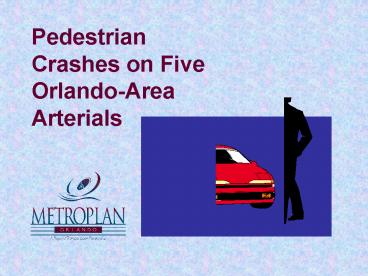Pedestrian Crashes on Five OrlandoArea Arterials - PowerPoint PPT Presentation
1 / 16
Title:
Pedestrian Crashes on Five OrlandoArea Arterials
Description:
Pedestrian Crashes on Five Orlando-Area Arterials. Scope of Study. All ... SR 50 (Lake Co. line to east end of SR 408) SR 436 (US 441 to Beeline Expressway) ... – PowerPoint PPT presentation
Number of Views:42
Avg rating:3.0/5.0
Title: Pedestrian Crashes on Five OrlandoArea Arterials
1
Pedestrian Crashes on Five Orlando-Area Arterials
2
Scope of Study
- All long-form crash reports
- From years 1993 through 1997
- US 17/92 (SR 50 to SR 46)
- US 441 (SR 50 to US 192)
- US 192 (Turnpike entrance to Lake Co. line)
- SR 50 (Lake Co. line to east end of SR 408)
- SR 436 (US 441 to Beeline Expressway)
3
Factors
- Date Time (8)
- Crash Type and Location Type (3)
- Pedestrian Demographics (5)
- Motorist Demographics (5)
- Alcohol Use (both)
- Injury Severity
- Traffic Control
- Sidewalk Presence
- Environmental Conditions (7)
- Lighting
- Weather
- Roadway Conditions
- Vehicle Type Defect (2)
- Posted Speed
- Estimated Speed
- Contributing Factors (both)
- Hit Run
- Citations Given
- Name of Nearest Signalized Intersection and
Pedestrian Amenities - Distance to Nearest Signal and/or Ped. Signal
- Number of Lanes
- Existence of Median
- Residence (Urban area, Florida, US, Foreign --
both ped and motorist) - Fault Misassigned?
4
Significance of These Crashes
While the five highways in the study only account
for about 1.5 of the total centerline miles of
streets in Orange, Seminole and Osceola Counties,
they experienced 17 of all pedestrian crashes
and 36 of all pedestrian deaths.
5
Number of Crashes by Type
6
Number of Fatalities by Type
7
On-Road Crashes By Location
8
Fatal On-Road Crashes By Location
9
Crashes by Lighting and Location
10
Round-Trip Walk Time to Nearest Traffic SignalOf
457 mid-block crashes. Based on 4 feet per second
walk rate includes 2 minute delay at signal.
11
Round-Trip Walk Time to Nearest Pedestrian
SignalOf 457 mid-block crashes. Based on 4 feet
per second walk rate includes 2 minute delay at
signal.
12
Pedestrian Alcohol Use
13
Motorist Contributing Factors When Pedestrians
Were Intoxicated
14
Injury Severity by Posted Speed
15
Signals per Mile
Percent Crashes Not at Signal
16
Fault by Place of Residence































